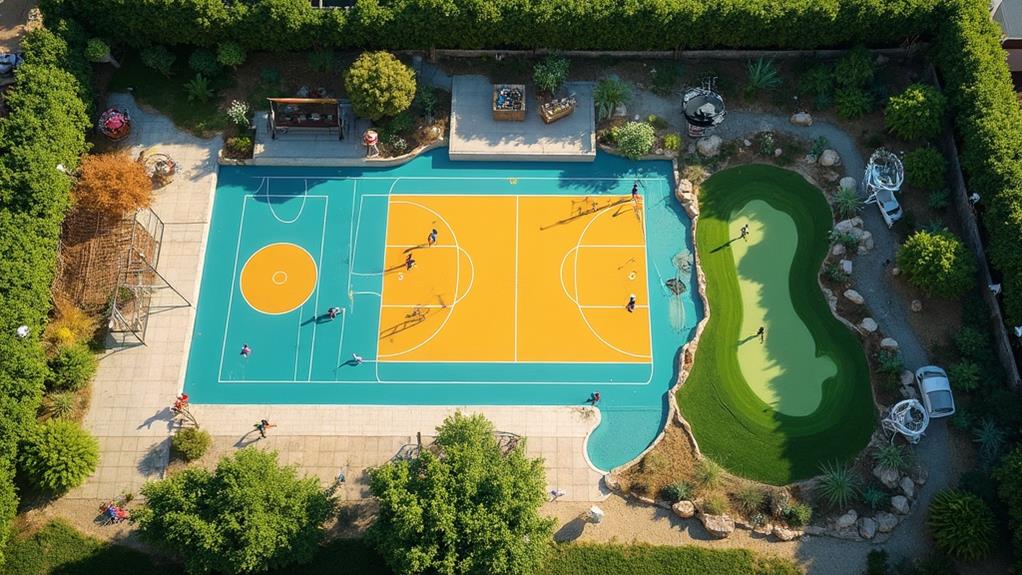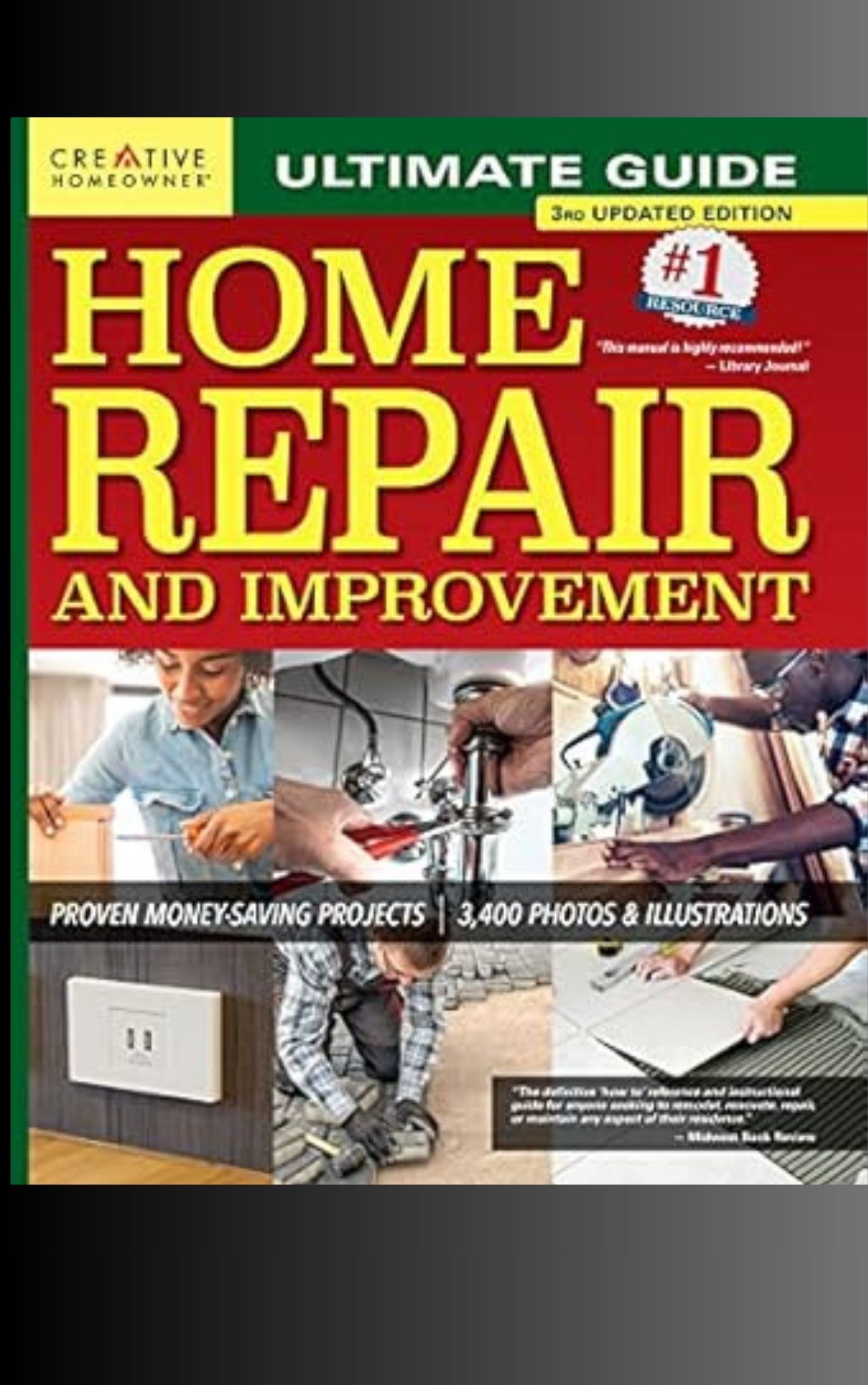Creating a backyard athletic zone requires careful planning and consideration. Start by assessing your space, measuring dimensions, and evaluating terrain. Choose sports that align with your interests and local climate. Design a layout that maximizes space efficiency and accommodates safety zones. Select appropriate surfaces for each sport, balancing versatility and specialization. Install adequate lighting for night play using energy-efficient LED floodlights. Prioritize safety with shock-absorbing materials and proper padding. Consider equipment storage, landscaping, and maintenance needs. By following these steps, you'll be well on your way to transforming your backyard into a dynamic sports haven.
Assessing Your Space
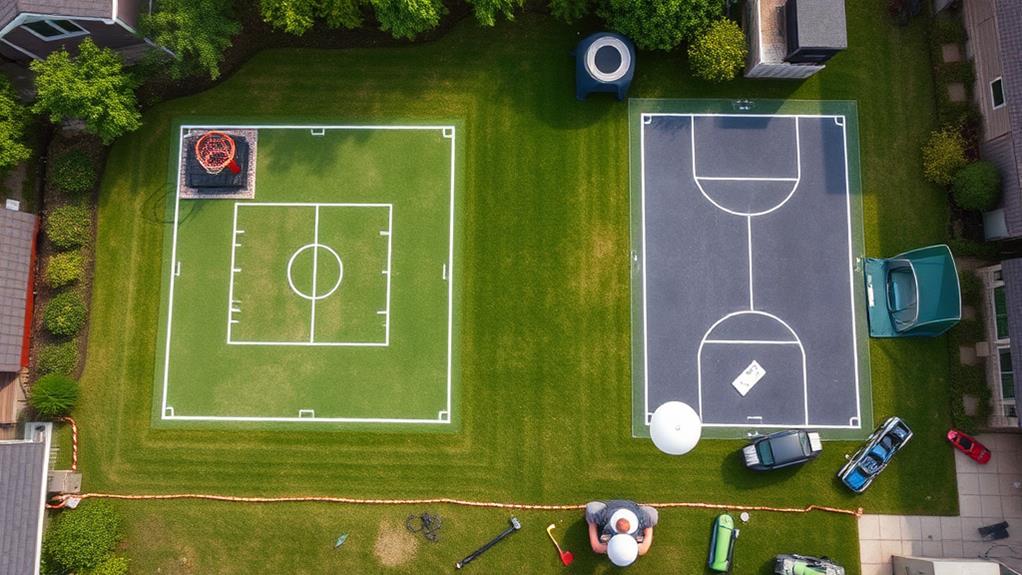
Before diving into any outdoor sports renovation project, it's crucial to thoroughly assess your available space. Consider the dimensions of your yard, taking accurate measurements of length, width, and any irregular shapes. Evaluate the terrain, noting slopes, existing structures, and natural features that may impact your plans.
Assess sunlight exposure throughout the day, as this affects the comfort and usability of sports areas. Identify potential obstacles like trees, utility lines, or property boundaries. Consider proximity to neighbors and local noise regulations when planning active zones.
Analyze soil composition and drainage patterns to determine if additional preparation is needed for stable surfaces. Take note of existing vegetation and decide which elements to preserve or remove. Evaluate access points for equipment and materials during construction.
Consider multi-use potential to maximize space efficiency. For example, a basketball court could double as a pickleball area. Prioritize safety by planning buffer zones between different activity areas and structures. Finally, review local zoning laws and homeowners' association rules to ensure compliance with outdoor renovation regulations.
Choosing Your Sports Focus
With a clear understanding of your available space, the next step is selecting the specific sports to feature in your outdoor renovation. Consider factors such as personal interests, family preferences, and local climate when making your decision. Popular options include basketball courts, tennis courts, soccer fields, and putting greens.
For smaller spaces, multi-purpose areas can be designed to accommodate various sports. For example, a concrete pad can serve as both a basketball court and a pickleball court with the addition of portable nets. Alternatively, focus on individual sports that require less space, such as a rock climbing wall or a compact fitness station.
If you have ample room, consider creating dedicated zones for different sports. This approach allows for simultaneous activities and caters to diverse interests. When choosing your sports focus, also factor in maintenance requirements and potential noise levels, especially if you live in a residential area. Finally, think about the long-term appeal of your chosen sports to ensure your renovation remains relevant and enjoyable for years to come.
Designing the Layout
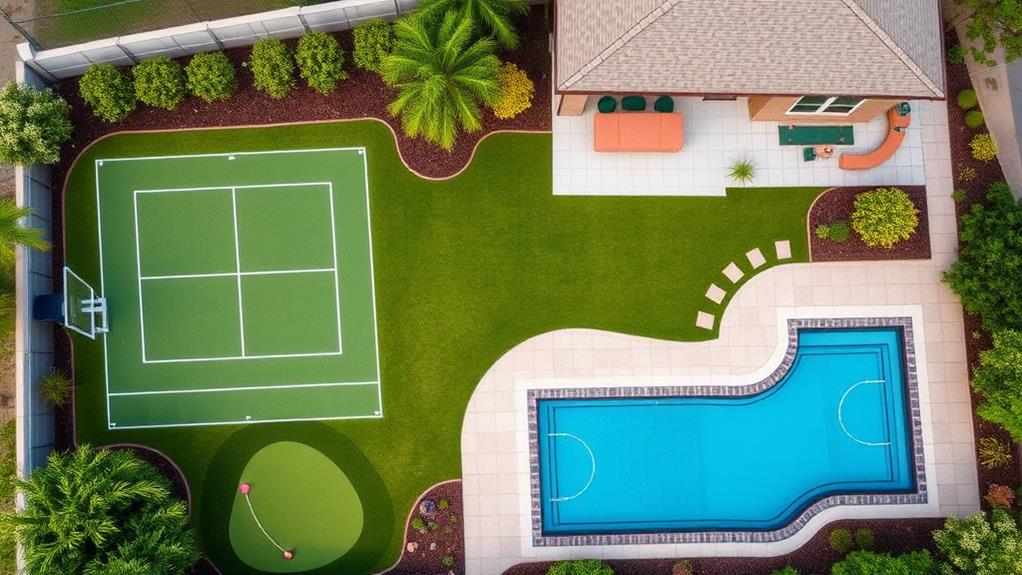
After selecting your sports focus, designing the layout becomes crucial for maximizing space and functionality. Begin by measuring your available area and creating a scaled diagram. Consider the dimensional requirements for each sport, including safety zones and equipment storage. Prioritize versatility by incorporating multi-purpose areas that can accommodate various activities.
Evaluate the terrain and address any grading issues to ensure proper drainage and level playing surfaces. Plan for adequate lighting to extend usability into evening hours. Include seating areas for spectators and participants' rest periods. If space allows, designate separate zones for different sports to minimize interference.
Consider the flow between areas, creating clear pathways and transitions. Incorporate natural elements like trees or shrubs as windbreaks or shade providers, but ensure they don't obstruct play. For multi-sport areas, use removable or adjustable equipment to facilitate quick transitions. Install appropriate surfaces for each sport, such as synthetic turf for soccer or a hard court for basketball. Lastly, factor in maintenance requirements when designing the layout to ensure long-term sustainability and ease of upkeep.
Selecting Appropriate Surfaces
The layout design sets the foundation for your outdoor sports area, but the surfaces you choose will greatly impact performance, safety, and maintenance. When selecting appropriate surfaces, consider the specific sports you plan to accommodate and the level of use the area will receive.
For multi-purpose courts, opt for versatile materials like acrylic or polyurethane coatings over concrete or asphalt. These surfaces provide good traction, shock absorption, and durability for activities like basketball, tennis, and volleyball.
For dedicated tennis courts, choose either hard court surfaces or clay, depending on playing preferences and climate conditions.
If creating a putting green, synthetic turf designed specifically for golf offers a consistent playing surface that requires minimal upkeep. For general lawn sports or practice areas, consider natural grass or high-quality artificial turf. Natural grass provides a softer playing surface but demands more maintenance, while artificial turf offers year-round usability with less upkeep.
For high-impact areas like basketball key zones or under playground equipment, consider installing rubber tiles or poured-in-place rubber surfacing to enhance safety and reduce the risk of injuries from falls.
Lighting for Night Play
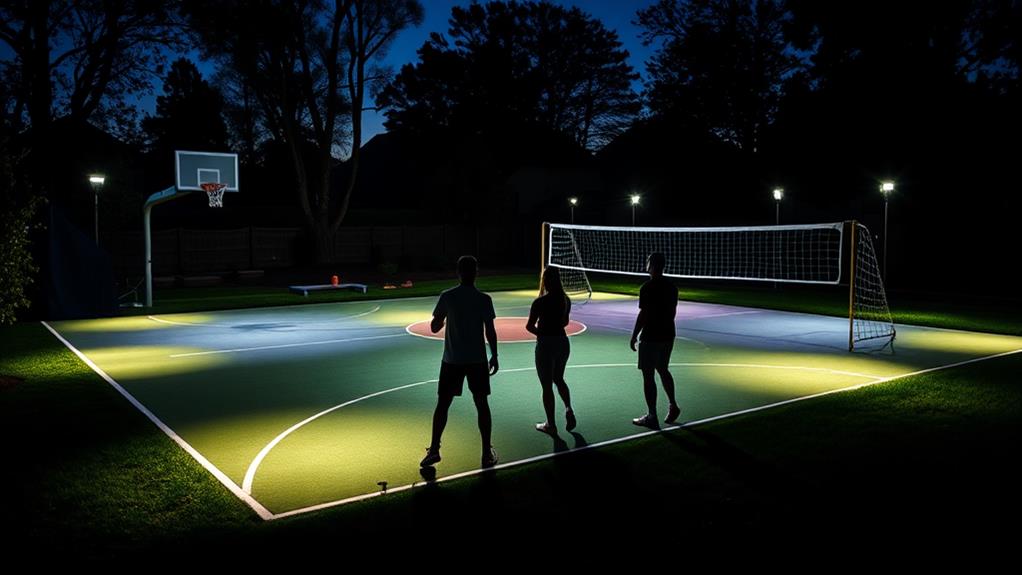
Proper lighting is essential for extending the usability of outdoor sports areas into the evening hours. When designing lighting for night play, consider factors such as brightness, coverage, and energy efficiency. LED floodlights are popular choices due to their longevity, low energy consumption, and ability to provide bright, uniform illumination.
For larger areas like tennis courts or basketball courts, install multiple light poles around the perimeter to ensure even distribution of light and minimize shadows. Smaller spaces may benefit from wall-mounted fixtures or adjustable spotlights. Consider using motion sensors or timers to conserve energy and reduce light pollution when the area is not in use.
Color temperature is another important aspect of sports lighting. Opt for cool white lights (5000-6500K) to improve visibility and reduce eye strain. Ensure that the lighting meets recommended lux levels for the specific sport being played. For example, recreational tennis typically requires 300-500 lux, while competitive play may need up to 750 lux.
Lastly, consider the impact on neighbors and local wildlife when planning your lighting setup. Use directional fixtures and glare shields to minimize light spill and focus illumination on the playing area.
Safety Considerations
When renovating outdoor sports areas, safety considerations should be at the forefront of every design decision. Proper surface materials are crucial to prevent injuries from falls and impacts. For high-impact sports, consider shock-absorbing surfaces like rubber mulch or specialized synthetic turf.
Ensure adequate padding on any hard structures, such as goal posts or court boundaries. Maintain clear zones around playing areas to prevent collisions with obstacles or spectators. Install appropriate fencing or netting to contain balls and protect surrounding property.
Address potential tripping hazards by leveling the ground and filling in holes or depressions. Weather protection is essential; install proper drainage systems to prevent water accumulation and reduce the risk of slips. For areas prone to high winds, secure loose equipment and consider wind-resistant structures.
Regular maintenance is key to ongoing safety. Inspect surfaces, equipment, and structures regularly for wear and damage. Promptly repair any issues to prevent accidents. Finally, ensure proper storage for equipment when not in use to avoid creating obstacles or hazards in the play area.
Equipment Storage Solutions
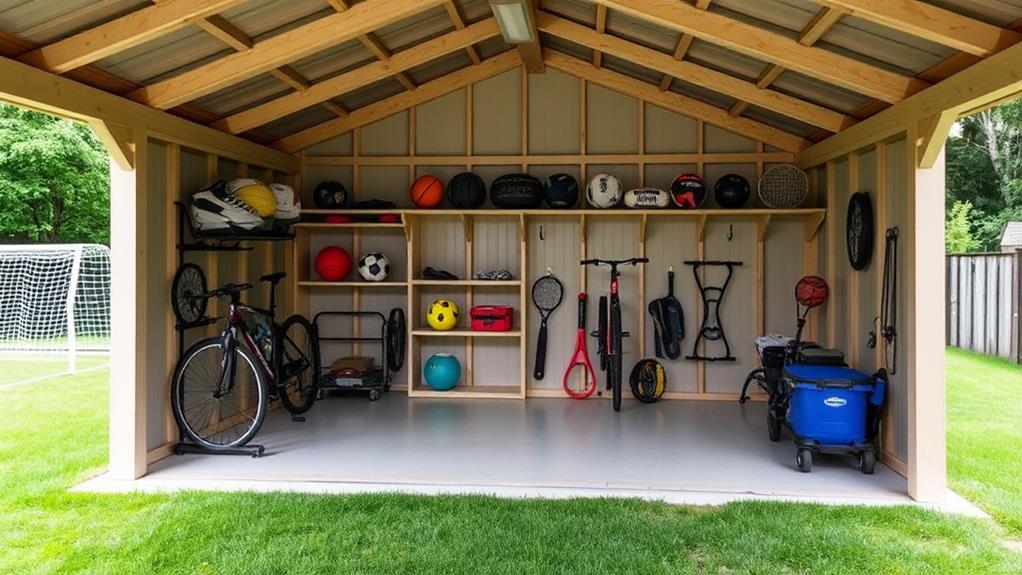
Efficient equipment storage solutions play a vital role in maintaining safety and organization in outdoor sports areas. When renovating for outdoor sports, consider incorporating dedicated storage spaces that protect equipment from weather elements and potential theft while keeping the area tidy and hazard-free.
Weather-resistant outdoor cabinets or sheds are ideal for storing larger items like balls, bats, and nets. These structures should be securely anchored and feature locks to prevent unauthorized access. For smaller items, wall-mounted racks or pegboards can maximize vertical space and keep equipment off the ground. Utilize hooks, shelves, and bins within these systems to accommodate various gear types.
Consider installing a combination of open and closed storage options. Open storage, such as ball carts or equipment bins, allows for quick access during active use, while closed storage protects items from prolonged exposure to the elements. Implement a labeling system to ensure easy identification and organization of equipment.
For multi-sport areas, modular storage solutions offer flexibility to adapt to changing needs. Additionally, incorporate proper drainage and ventilation in storage areas to prevent moisture buildup and equipment degradation.
Landscaping Around Athletic Areas
Landscaping around athletic areas serves multiple purposes beyond mere aesthetics. It can enhance safety, improve functionality, and create a more enjoyable environment for sports activities. When planning landscaping for athletic zones, consider using low-maintenance, drought-resistant plants that can withstand the impact of stray balls and foot traffic.
Incorporate strategic placement of trees and shrubs to provide natural windbreaks and shade for players and spectators. However, ensure that vegetation doesn't interfere with gameplay or create hazards. Install proper drainage systems to prevent water accumulation on playing surfaces, and use appropriate ground cover or turf to reduce erosion and maintain field quality.
For multi-sport areas, consider using removable or adjustable landscaping elements that can adapt to different game requirements. Integrate seating areas and viewing spots within the landscape design to accommodate spectators comfortably. Use landscaping to clearly define boundaries between different athletic zones and separate them from other backyard areas.
Lastly, consider lighting options that complement the landscape while providing adequate illumination for evening practices or games. Solar-powered pathway lights or strategically placed floodlights can enhance both safety and aesthetics in your outdoor athletic space.
Maintenance and Upkeep
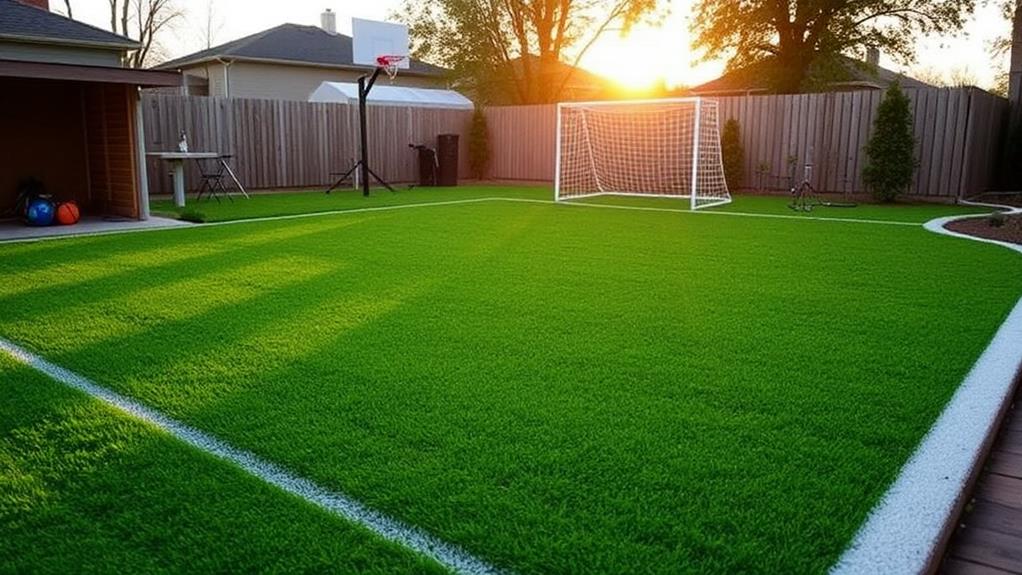
Maintaining outdoor sports areas is crucial for ensuring their longevity, safety, and optimal performance. Regular upkeep tasks include mowing grass surfaces, repairing damaged areas, and inspecting equipment for wear and tear.
For natural turf fields, proper irrigation, fertilization, and aeration are essential to maintain a healthy playing surface. Synthetic turf requires periodic brushing, infill replenishment, and deep cleaning to prevent compaction and maintain its shock-absorption properties.
Court surfaces like tennis or basketball courts need regular sweeping, pressure washing, and repainting of lines to preserve their playability and appearance. Inspect fencing, netting, and other boundary structures for damage and repair promptly to ensure player safety. Regularly check and maintain lighting systems, replacing bulbs and cleaning fixtures as needed.
Implement a routine inspection schedule to identify potential hazards or maintenance issues early. This proactive approach can prevent more extensive and costly repairs down the line. Consider seasonal maintenance tasks, such as winterizing irrigation systems or preparing surfaces for heavy use during peak seasons. By dedicating time and resources to consistent maintenance, you can extend the life of your outdoor sports areas and provide a safe, enjoyable experience for users.
Maximizing Year-Round Usage
With proper maintenance in place, the focus shifts to maximizing the use of outdoor sports facilities throughout the year. To achieve this, consider implementing versatile designs that accommodate multiple sports and activities.
Install all-weather surfaces like synthetic turf or rubberized flooring to enable play in various conditions. Incorporate proper drainage systems to prevent water accumulation and ensure quick drying after rainfall.
Lighting is crucial for extending usage hours into the evening. Install energy-efficient LED lights that provide adequate illumination without excessive glare. For colder months, consider adding heating elements to key areas, such as seating zones or high-traffic spots.
Retractable awnings or permanent shade structures can protect users from harsh sun or light rain, expanding usability during inclement weather. Create windbreaks using strategically placed fencing, hedges, or screens to reduce wind chill and improve comfort.
For multi-purpose spaces, invest in easily movable equipment and storage solutions that allow quick transitions between different sports or activities. Finally, consider seasonally appropriate landscaping to enhance the aesthetic appeal and functionality of the space year-round, ensuring your outdoor sports area remains an inviting destination regardless of the season.
Frequently Asked Questions
How Much Does a Typical Backyard Athletic Zone Renovation Cost?
The cost of a typical backyard athletic zone renovation varies widely, ranging from $5,000 to $50,000 or more. Factors influencing the price include size, materials, equipment, landscaping, and any necessary permits or professional installation services.
Can I Install Athletic Zones in Small Urban Backyards?
Like a compact Swiss Army knife, small urban backyards can pack a surprising punch. Yes, you can install athletic zones in limited spaces. Creative design, multi-purpose equipment, and vertical solutions allow for efficient use of available area for various sports activities.
Are There Zoning Laws or Permits Required for Backyard Sports Areas?
Zoning laws and permit requirements for backyard sports areas vary by location. Check with your local municipality or homeowners' association for specific regulations. Some factors to consider include noise, lighting, and structure height limitations.
How Can I Soundproof My Backyard Athletic Zone to Avoid Disturbing Neighbors?
To soundproof your backyard athletic zone, consider installing acoustic fencing, planting dense vegetation as sound barriers, using sound-absorbing materials on hard surfaces, and positioning noisy activities away from property lines. Consult local regulations regarding noise ordinances for additional guidance.
What Are Eco-Friendly Options for Creating and Maintaining Backyard Sports Areas?
Eco-friendly options for backyard sports areas include using recycled materials for surfaces, installing drought-resistant grass, implementing rainwater collection systems, utilizing solar-powered lighting, and choosing organic maintenance products. These choices minimize environmental impact while creating sustainable recreational spaces.
Conclusion
In summation, the creation of backyard athletic zones requires meticulous planning and execution. From initial space assessment to long-term maintenance, each step contributes to a functional and aesthetically pleasing sports area. By carefully considering surface options, illumination, and storage solutions, homeowners can transform their outdoor spaces into versatile athletic venues. With proper landscaping and year-round optimization strategies, these bespoke sporting grounds can become the cynosure of neighborhood recreation, fostering physical activity and community engagement.
